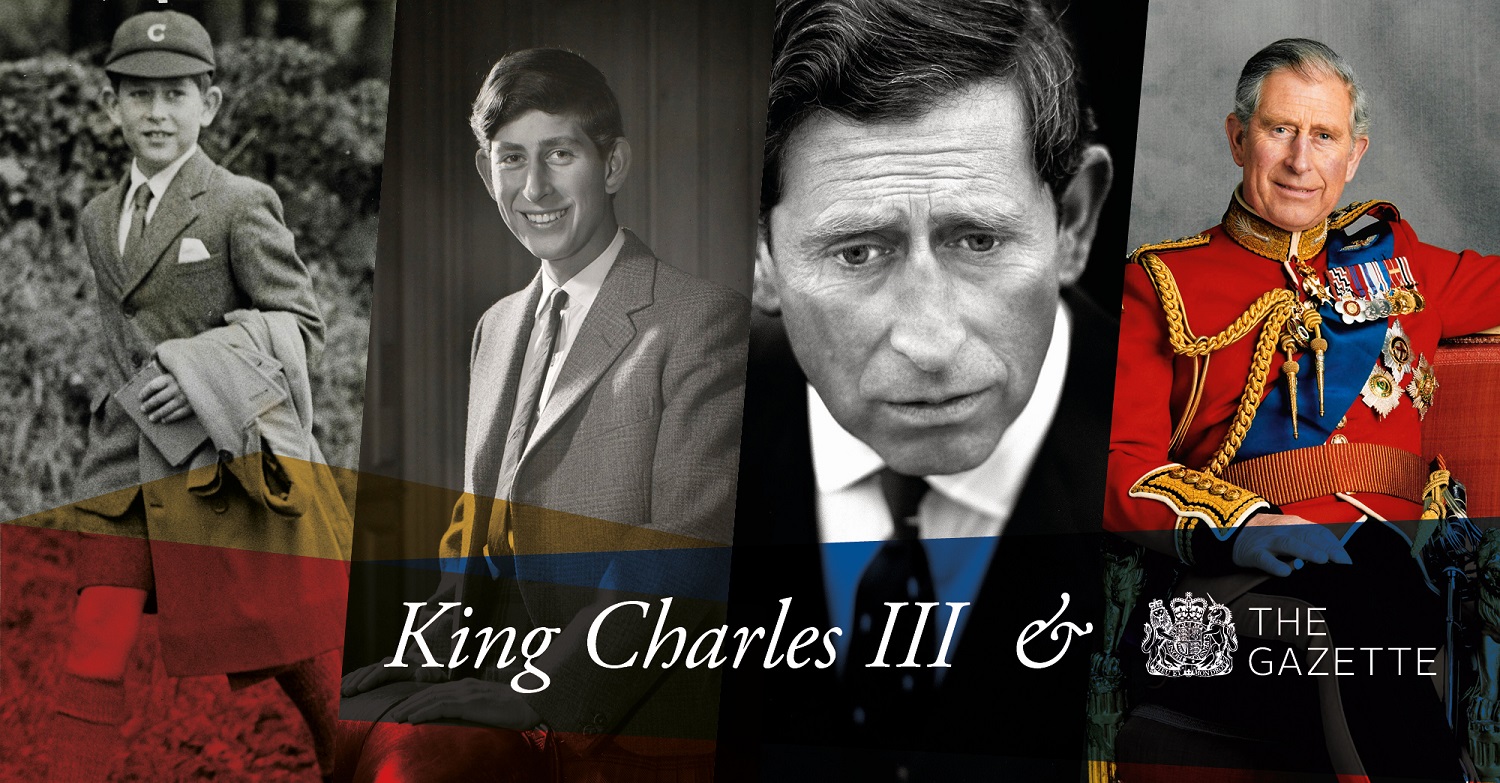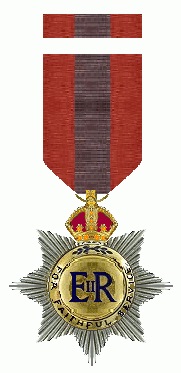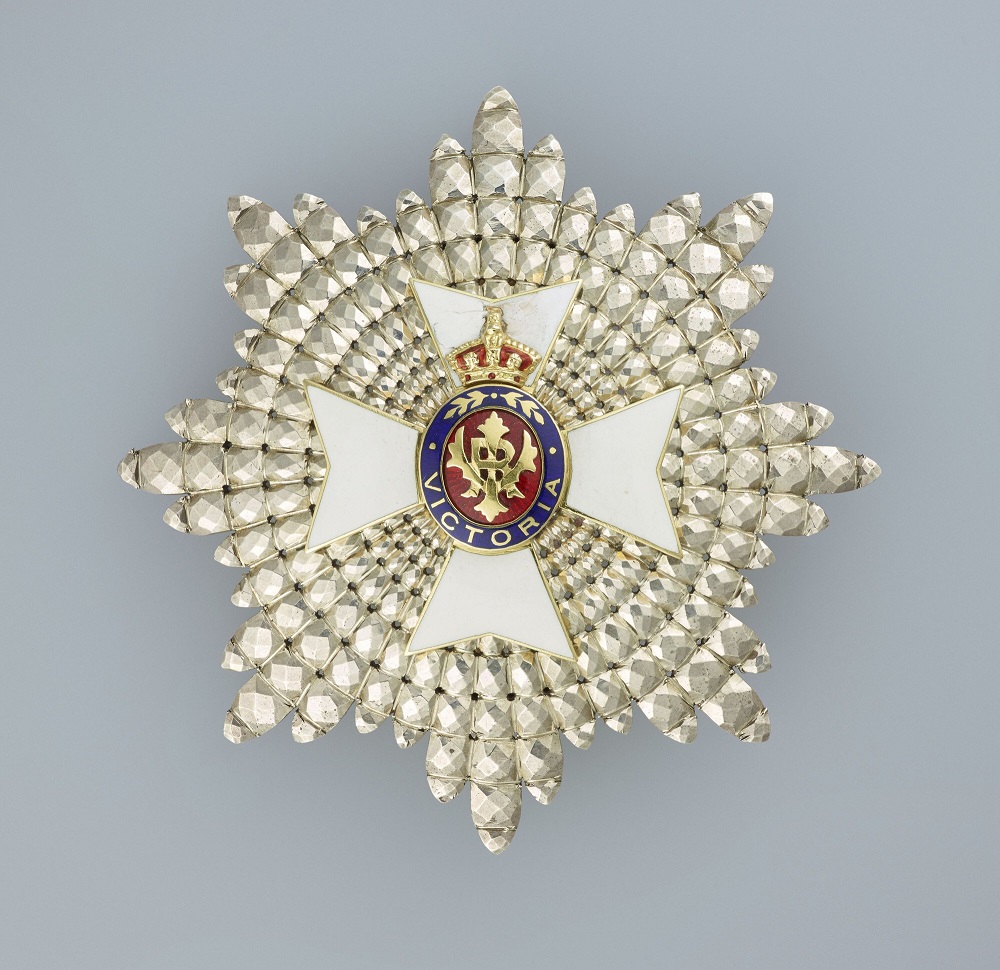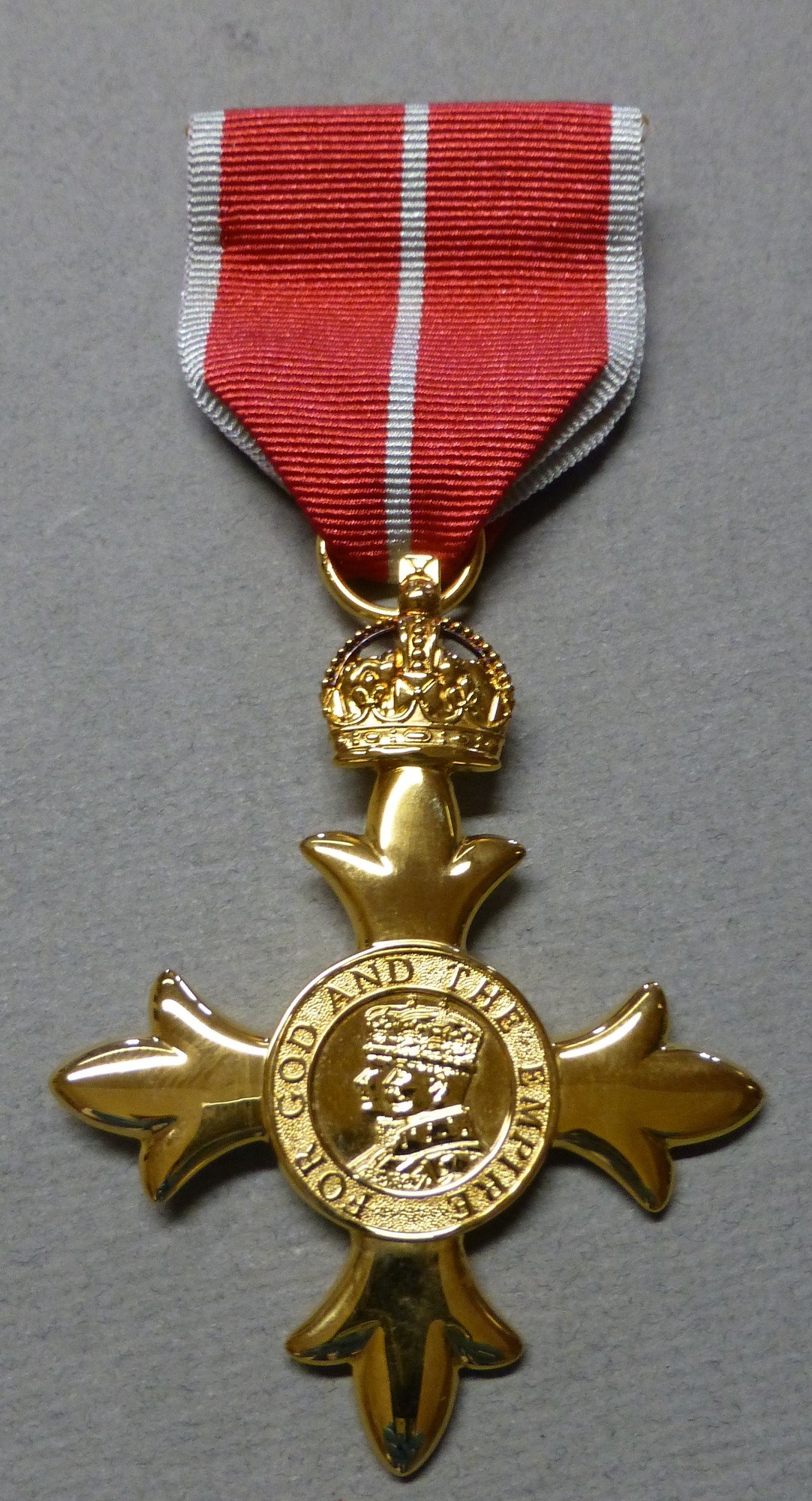King Charles III and The Gazette: British honours

Ahead of the coronation due to take place on Saturday 6 May 2023, historian Russell Malloch examines aspects of the new King’s life that have left a record in The Gazette. In this chapter, we look at Charles III’s relationship with the British honours system and his role at investitures.
Chapters
British honours
The Prince of Wales had joined four of the British orders before he succeeded to the Crown in September 2022. He had started by entering the Garter in 1958, and then gained places in the Orders of the Bath and the Thistle in the 1970s, before ending up as a member of the Order of Merit in 2002. He also received the official medals that commemorated his mother’s coronation in 1953, and her jubilees in 1977, 2002, 2012 and 2022.
This distribution of favours concealed the fact that the allocation of honours within the royal family was far from uniform, and that Prince Charles was treated differently by comparison with some of his predecessors as prince of Wales, some of whom had joined the first class of the other orders of knighthood, or automatically become companions of the Imperial Service Order when they received the Welsh dignity.

Imperial Service Order
The Imperial Service Order had a special relationship with the principality of Wales, and one that it shared with only one other order, the Garter. The order was instituted at the time of Edward VII’s coronation in 1902, when the statutes directed that “the order shall consist of the sovereign, the Prince of Wales, and such companions as we, our heirs or successors, shall appoint” (Gazette issue 27463).
The link with the Welsh title was an odd provision, but one that helped to enhance the prestige of the new honour, whose main purpose was to reward the work of relatively low-ranking civil servants across the British Empire. Members had precedence after the companions of all of the other orders.
The coronation plan was implemented, and in March 1903 The Gazette confirmed that the then Prince of Wales had become a companion of the Imperial Service Order (ISO) (Gazette issue 27539). The prince added the order’s star-shaped badge to his medal bar, and continued to wear the insignia after he became sovereign in 1910.
The next holder of the Welsh dignity, the future Edward VIII, became a companion when he was made prince of Wales in June 1910, although The Gazette did not record his admission to the Imperial Service Order, and he did not follow his father’s example by wearing its insignia.
The structure of the order was altered one month after Prince Charles was born, when the statutes of 14 December 1948 discontinued the special ISO for the prince of Wales. There was of course no holder of the Welsh dignity at that time, but no attempt was made to revive the Welsh link when the order’s statutes were next revised in 1954, or even a few years later after Charles became prince of Wales.
Other honours
The Imperial Service Order was not the only honour that Prince Charles did not receive insignia that was worn by some of his more recent predecessors as prince of Wales.
By November 1948 the altered state of relations between the United Kingdom and the dominion of India meant that there was no question of members of the royal family becoming grand commanders of the two Indian orders - the Star of India (GCSI) and the Indian Empire (GCIE) – as had happened with each of the future kings Edward VII, George V and Edward VIII.
Prince Charles was also not admitted as a grand cross of the Order of St Michael and St George (GCMG) or the Victorian Order (GCVO) or assigned a place in the Order of St John. There were several relevant precedents, starting with Edward VII who, while Prince of Wales, received the GCMG and was a member and grand prior of the Order of St John by March 1896, when The Gazette began to provide information about that order and its members. He was also one of the first GCVOs to be appointed in May 1896.
George V had joined the Order of St John by the time of the 1896 Gazette and received the GCVO on the occasion of his grandmother’s jubilee in 1897. He added the GCMG in March 1901 in connection with his tour of the British Empire. Next there was Edward VIII who was gazetted as a knight of St John in June 1917 and a GCMG in November of that year when he became the grand master of the overseas order, and gained the GCVO in 1920 when he left to visit the British dominions.
Finally, the insignia of the three orders was presented to George VI while he was Duke of York, as he was gazetted as a GCVO and knight of St John in 1921 and appointed a GCMG in 1926 before he left England to visit Australia and New Zealand.
Prince Charles travelled more extensively than any previous heir to the throne, but even as the future head of the Commonwealth he was never admitted to the overseas order. This reflected a changed policy as regards the distribution of honours within the royal family, and during Queen Elizabeth’s reign the only “family” GCMG was her cousin Edward, Duke of Kent, whose award was directly linked to his appointment as grand master of the order in November 1967.

Victorian Order
Prince Charles also did not join the Victorian Order. This was especially surprising as the grand cross was conferred on his sister and brothers.
Princess Anne received the GCVO in October 1974, a few months after she was confronted by an armed attacker in London. Her brothers Andrew and Edward both joined the order at the level of commander (CVO) in 1979 (Gazette issue 48072) and 1989 (Gazette issue 51673) respectively, and were advanced to knight commander (KCVO) at the same time on the 50th anniversary of their mother’s coronation in 2003 (Gazette issue 56951), and finally progressed to the most senior grade of GCVO in 2011 (Gazette issue 59705 and Gazette issue 59724).
This uneven distribution of honours was also demonstrated in the case of the Duke of Edinburgh, who received the grand cross of the Victorian Order more than 40 years after his daughter, being presented with the insignia at the age of 96 on the occasion of his 70th wedding anniversary.
As regards to the other honours that fell within the Queen’s personal gift, it is significant that Prince Charles did not receive the Royal Victorian Chain, a decoration that Edward VII established at the time of his coronation, and indicated what the regulations referred to as “a mark of the highest distinction and special favour on the part of the sovereign.”
The Queen limited the family distribution of this rare distinction to her sister and husband. Princess Margaret was honoured in 1990 on the occasion of her 60th birthday (Gazette issue 13769), while the Duke of Edinburgh was invested on his 60th wedding anniversary (Gazette issue 58519). This sparing use of the Chain was in marked contrast to its role under George V, who granted the decoration to all four of his surviving sons (the Prince of Wales and the dukes of York, Gloucester and Kent).
Since 1952 the Chain has mainly been confined to foreign heads of state, senior members of the royal household, and successive archbishops of Canterbury.
Investitures
Prince Charles may not have joined all of the orders of knighthood, but he was familiar with their insignia through his role at investitures, during which he presented the badges and stars to members of the various orders.
The Gazette reported several occasions when the prince worked in connection with the day-to-day operation of the honours system, but the notices only recorded his role in conferring the honour of knighthood on those men who had received the dignity of knight bachelor.
This ceremonial part of the royal function was delegated to several counsellors of state before November 1966, when Prince Charles became eligible to act in that capacity. The Gazette noticed more than 300 persons who were knighted by the Queen Mother between 1952 and 1986, when she last wielded the sword on her daughter’s behalf. The Duke of Edinburgh played a more limited role, but still managed to knight more than 100 individuals between 1958 and 1964, while the Duke of Kent assisted the Queen between 1967 and 1977.
Prince Charles’s involvement in the process began in Africa during a two week visit to Kenya, the country in which his mother learned about her accession to the throne. On 16 February 1971, at the residence of the British High Commissioner in Nairobi, he knighted Sir William Duffus, the Jamaican born president of the Court of Appeal for East Africa, using a sword he received after becoming colonel-in-chief of the Royal Regiment of Wales (Gazette issue 45328). Photographs of the Kenyan ceremony appeared in the press at the start of what would be more than 50 years of involvement with the operational side of the British honours system before he succeeded to the Crown.1
The prince played only a modest part in the knighthood ritual before the early 1990s, but then acted on a more regular basis, and eventually dubbed more than 550 knights since his Kenyan mission in 1971. During the 21st century The Gazette reported the prince knighting candidates such as the writer Malcolm Bradbury and the singer Mick Jagger; the astronomer Patrick Moore; the cyclist Chris Hoy and cricketer Geoffrey Boycott, and business figures such as Richard Branson and James Dyson. He also brought a Welsh dimension to the ceremonial by knighting several men at Cardiff Castle, as in April 1999 when he dubbed the landscape painter Kyffin Williams (Gazette issue 55610).
Three of the “prince’s knights” were given roles at the Queen’s state funeral in September 2022. He knighted Narendra Patel, the president of the Royal College of Obstetrics and Gynaecology; Patrick Vallance, the government’s chief scientific adviser; and Christopher Greenwood of the London School of Economics, who walked in the procession in Westminster Abbey as representative members of the orders of the Thistle, Bath and British Empire.

The Gazette restricted its reporting of ceremonial to the dubbing of the knights bachelors and did not record the prince’s wider role at investitures, where the principal business usually involved the insignia of the Order of the British Empire. In 1971 the order’s badge, bearing images of the prince’s great-grandparents George and Mary, was taken to Nairobi where the prince followed his first knighthood by investing the auditor-general of the East African Community as a CBE, and handing an OBE badge to the chief executive officer of the Agricultural Society of Kenya.
Prince Charles’s relationship with several private and public organisations was reflected in The Gazette by way of the award of honours, and in particular appointments to the Victorian Order for services that supported his personal and professional interests.
Examples of the more personal honours include a knight commander level award for Angus Ogilvy for his work with the Prince’s Youth Business Trust in 1988 (Gazette issue 51578), and a dame commander’s place (DCVO) in 2016 for Martina Milburn (Gazette issue 61803), the chief executive of the Prince’s Trust Group. There was also a commander’s badge in 2022 for Dame Jayne-Anne Gadhia (Gazette issue 63714), the chair of the Prince’s Foundation that was formed through the merger of the Prince’s Foundation for Building Community, the Prince’s Regeneration Trust and the Prince’s School of Traditional Arts.
The Gazette also announced honours for members of the prince’s household, starting with Squadron Leader David Checketts, who began his royal career as an equerry to the Duke of Edinburgh, and went to Australia in 1966 to accompany Prince Charles at Timbertop, the mountain branch of the Geelong Church of England Grammar School. After returning to England, Checketts became the prince’s first equerry in January 1967 (Gazette issue 44224), and his first private secretary in August 1970 (Gazette issue 45181).
David Checketts was made a member of the Victorian Order when he completed his tour of duty with the Duke of Edinburgh and was advanced to CVO in the Caernarvon honours list of July 1969 (Gazette issue 44888). He was finally knighted and invested by the Queen as a KCVO at Buckingham Palace on 30 April 1979 on relinquishing his appointment as the prince’s private secretary (Gazette issue 47842).
Several senior personnel received a similar form of recognition, as with the CVO for Sir David’s successors as private secretary, starting with Edward Adeane in 1985 (Gazette issue 50084), then John Riddell (Gazette issue 52159), Richard Aylard (Gazette issue 53696) and Stephen Lamport (Gazette issue 55513), and ending with Clive Alderton (Gazette issue 62666), the former ambassador to Morocco, who joined the prince’s household in 2015 and was advanced to KCVO in 2022 (Gazette issue 63714), shortly before he became the King’s principal private secretary
The Gazette recorded awards of the Royal Victorian Medal (RVM) to some of the prince’s more junior employees, including a cook, gardener and house manager at the Highgrove estate, which was purchased by the Duchy of Cornwall in 1980 and became one of the prince’s main residences. There were also medals for employees who helped at some of the older royal establishments such as Clarence House in London, and Birkhall in Aberdeenshire.
A few personal staff were noticed, including the Victorian Medals in 2007 for the prince’s butler Antony Rabey (Gazette issue 58358) and his head valet Lee Dobson (Gazette issue 58557), both of whom later joined the Victorian Order.
About the author
Russell Malloch is a member of the Orders and Medals Research Society and an authority on British honours.
See also
The Accession of King Charles III
Succession to the Crown: An introduction
Gazette Firsts: The history of The Gazette and royal coronations
Images
The Gazette
Robert Prummel
Royal Collection Trust / © His Majesty King Charles III 2023
Royal Collection Trust / © His Majesty King Charles III 2023
References
- The Times, 17 February 1971, page 6.
Publication date: 20 April 2023
Any opinion expressed in this article is that of the author and the author alone, and does not necessarily represent that of The Gazette.
